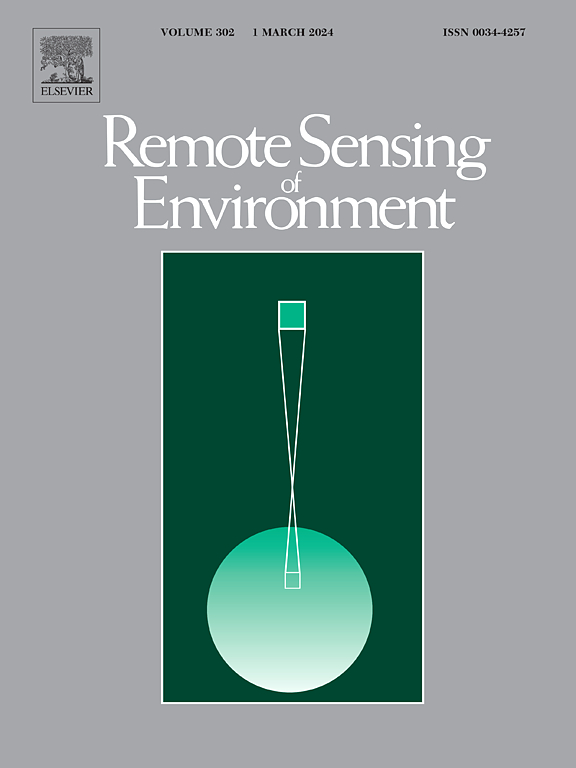Combining geometric-optical and spectral invariants theories for modeling canopy fluorescence anisotropy
IF 11.1
1区 地球科学
Q1 ENVIRONMENTAL SCIENCES
引用次数: 0
Abstract
The spectral invariants theory (-theory) has received much attention in the field of quantitative remote sensing over the past few decades and has been adopted for modeling of canopy solar-induced chlorophyll fluorescence (SIF). However, the spectral invariant properties (SIP) in simple analytical formulae have not been applied for modeling canopy fluorescence anisotropy primarily because they are parameterized in terms of leaf total scattering, which precludes the differentiation between forward and backward leaf SIF emissions. In this study, we have developed the canopy-SIP SIF model by combining geometric-optical (GO) theory to account for asymmetric leaf SIF forward and backward emissions at the first-order scattering and by modeling multiple scattering based on the -theory, thus avoiding the dependence on radiative transfer models. The applicability of the model simulations especially over 3D heterogeneous canopies was improved by incorporating canopy structure through multi-angular clumping index, and by modeling single scattering from the four components of the scene in view according to the GO approach. The results show good consistency with both the state-of-the-art SIF models and multi-angular field SIF observations over grass and chickpea canopies. The coefficient of determination (R2) between the simulated SIF and field measurements was 0.75 (red) and 0.74 (far-red) for chickpea, and 0.65 (both red and far-red) for grass. The average relative error was approximately 3 % for 1D homogeneous scenes when comparing the canopy-SIP SIF model simulations to the SCOPE model simulations, and around 4 % for the 3D heterogeneous scene when comparing to the LESS model simulations. The results indicate that the proposed approach for separating asymmetric leaf SIF emissions is a robust way to keep a balance between satisfactory simulation accuracy and efficiency. Model simulations suggest that neglecting the leaf SIF asymmetry can lead to an underestimation of canopy red SIF by 6.3 % to 42.6 % for various leaf biochemical and canopy structural parameters. This study presents a simple but efficient analytical approach for canopy fluorescence modeling, with potential for large-scale canopy fluorescence simulations.
结合几何光学和光谱不变量理论模拟冠层荧光各向异性
近几十年来,光谱不变量理论(p-theory)在定量遥感领域受到了广泛的关注,并被用于树冠太阳诱导叶绿素荧光(SIF)的建模。然而,简单解析公式中的光谱不变性(SIP)尚未应用于模拟冠层荧光各向异性,主要是因为它们是根据叶片总散射参数化的,这就排除了区分叶片前向和后向SIF发射。在本研究中,我们结合几何光学理论(GO)建立了冠层- sip SIF模型,该模型考虑了非对称叶片SIF在一阶散射下的前向和后向发射,并基于p-理论建立了多重散射模型,从而避免了对辐射传输模型的依赖。通过多角度聚块指数结合冠层结构,并根据GO方法对视场中四个分量的单散射进行建模,提高了模型模拟的适用性,特别是在三维非均匀冠层上。结果表明,该模型与草地和鹰嘴豆冠层上的多角度场SIF观测结果具有良好的一致性。模拟SIF与现场测量值的决定系数(R2)分别为:鹰嘴豆0.75(红色)和0.74(远红色),草0.65(红色和远红色)。与SCOPE模型模拟相比,树冠- sip SIF模型模拟的一维均匀场景的平均相对误差约为3%,而与LESS模型模拟相比,三维非均匀场景的平均相对误差约为4%。结果表明,所提出的分离非对称叶片SIF排放的方法是保持令人满意的模拟精度和效率之间平衡的一种鲁棒方法。模型模拟表明,忽略叶片SIF的不对称性会导致各种叶片生化参数和冠层结构参数对冠层红色SIF的低估6.3% ~ 42.6%。本研究提出了一种简单而有效的树冠荧光建模分析方法,具有大规模树冠荧光模拟的潜力。
本文章由计算机程序翻译,如有差异,请以英文原文为准。
求助全文
约1分钟内获得全文
求助全文
来源期刊

Remote Sensing of Environment
环境科学-成像科学与照相技术
CiteScore
25.10
自引率
8.90%
发文量
455
审稿时长
53 days
期刊介绍:
Remote Sensing of Environment (RSE) serves the Earth observation community by disseminating results on the theory, science, applications, and technology that contribute to advancing the field of remote sensing. With a thoroughly interdisciplinary approach, RSE encompasses terrestrial, oceanic, and atmospheric sensing.
The journal emphasizes biophysical and quantitative approaches to remote sensing at local to global scales, covering a diverse range of applications and techniques.
RSE serves as a vital platform for the exchange of knowledge and advancements in the dynamic field of remote sensing.
 求助内容:
求助内容: 应助结果提醒方式:
应助结果提醒方式:


